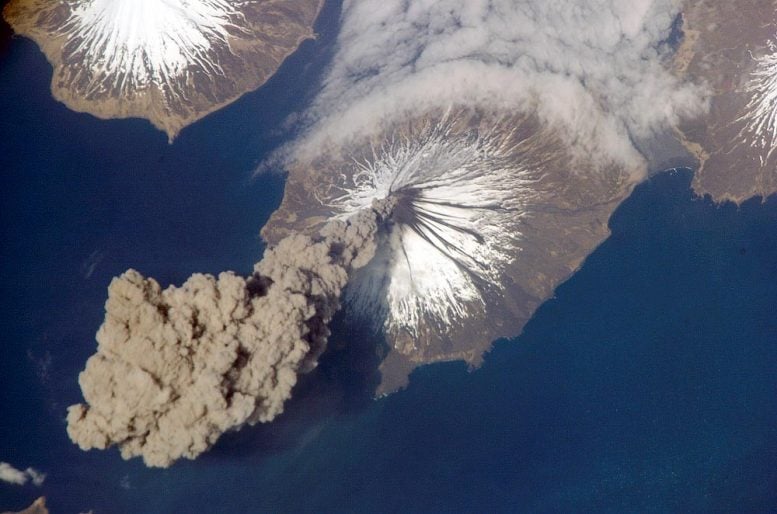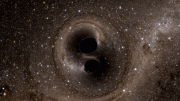
Cleveland Volcano, Aleutian Islands eruption in 2006. Volcanism is one of the main carbon dioxide sources in the long-term carbon cycle balanced by weathering sinks, which, among others, represent important processes included in Komar and Zeebe’s model. Credit: NASA image courtesy Jeff Williams
Predictions of future climate change require a clear and nuanced understanding of Earth’s past climate. In a study published today (January 22, 2021) in Science Advances, University of Hawai’i (UH) at Mānoa oceanographers fully reconciled climate and carbon cycle trends of the past 50 million years — solving a controversy debated in the scientific literature for decades.
Throughout Earth’s history, global climate and the global carbon cycle have undergone significant changes, some of which challenge the current understanding of carbon cycle dynamics.
Less carbon dioxide in the atmosphere cools Earth and decreases weathering of rocks and minerals on land over long time scales. Less weathering should lead to a shallower calcite compensation depth (CCD), which is the depth in the ocean where the rate of carbonate material raining down equals the rate of carbonate dissolution (also called “snow line”). The depth of the CCD can be traced over the geologic past by inspecting the calcium carbonate content of seafloor sediment cores.
Former oceanography graduate student Nemanja Komar and professor Richard Zeebe, both at the UH Mānoa School of Ocean and Earth Science and Technology (SOEST), applied the most comprehensive computer model of the ocean carbonate chemistry and CCD to date, making this the first study that quantitatively ties all the important pieces of the carbon cycle together across the Cenozoic (past 66 million years).

Deep sea fossilized skeletons from 45 million years ago found in sediment cores provide scientists means to date cores and to infer past ocean chemistry, temperature and more. Credit: Stanley A. Kling. Scripps Institution of Oceanography Photographs
Contrary to expectations, the deep-sea carbonate records indicate that as atmospheric carbon dioxide (CO2) decreased over the past 50 million years, the global CCD deepened (not shoaled), creating a carbon cycle conundrum.
“The variable position of the paleo-CCD over time carries a signal of the combined carbon cycle dynamics of the past,” said Komar, lead author of the study. “Tracing the CCD evolution across the Cenozoic and identifying mechanisms responsible for its fluctuations are therefore important in deconvolving past changes in atmospheric CO2, weathering, and deep-sea carbonate burial. As CO2 and temperature dropped over the Cenozoic, the CCD should have shoaled but the records show that it actually deepened.”
Komar and Zeebe’s computer model allowed them to investigate possible mechanisms responsible for the observed long-term trends and provide a mechanism to reconcile all the observations.
“Surprisingly, we showed that the CCD response was decoupled from changes in silicate and carbonate weathering rates, challenging the long-standing uplift hypothesis, which attributes the CCD response to an increase in weathering rates due to the formation of the Himalayas and is contrary to our findings,” said Komar.
Their research suggests that the disconnect developed partially because of the increasing proportion of carbonate buried in the open ocean relative to the continental shelf due to the drop in sea level as Earth cooled and continental ice sheets formed. In addition, ocean conditions caused the proliferation of open-ocean carbonate-producing organisms during that period of time.
“Our work provides new insight into the fundamental processes and feedbacks of the Earth system, which is critical for informing future predictions of changes in climate and carbon cycling,” said Komar.
The researchers are currently working on new techniques to constrain the chronology of climate and carbon cycle changes over the past 66 million years.
Reference: “Reconciling atmospheric CO2, weathering, and calcite compensation depth across the Cenozoic” by Nemanja Komar and Richard E. Zeebe, 22 January 2021, Science Advances.
DOI: 10.1126/sciadv.abd4876









“Throughout Earth’s history, global climate and the global carbon cycle have undergone significant changes, SOME OF WHICH CHALLENGE THE CURRENT UNDERSTANDING OF CARBON CYCLE DYNAMICS.”
What, the science isn’t settled? Where is Diogenes with his lantern when we need him? We may have found an honest man for him!
I want to thank the authors for honestly reporting findings vs. having a predetermined outcome and coming up with “stuff” to support that outcome. This study bring back the “wonder of science” and again, re-emphasizes just how little we know, or thing we know.
And while 50 million years sounds like a lot, if put in human life-span terms, that represents about 10 months, so still a lot to learn. But at least it is substantially more that the 1,000 years that is typically sited, representing mere seconds of a human life.
Just curious; would not these finding perhaps point to a mechanism such that when the earth is cool, more CO2 is retained in the planets waters and as the planet warms, CO2 is released from those now warmer waters into the atmosphere? Simple chemistry principles.